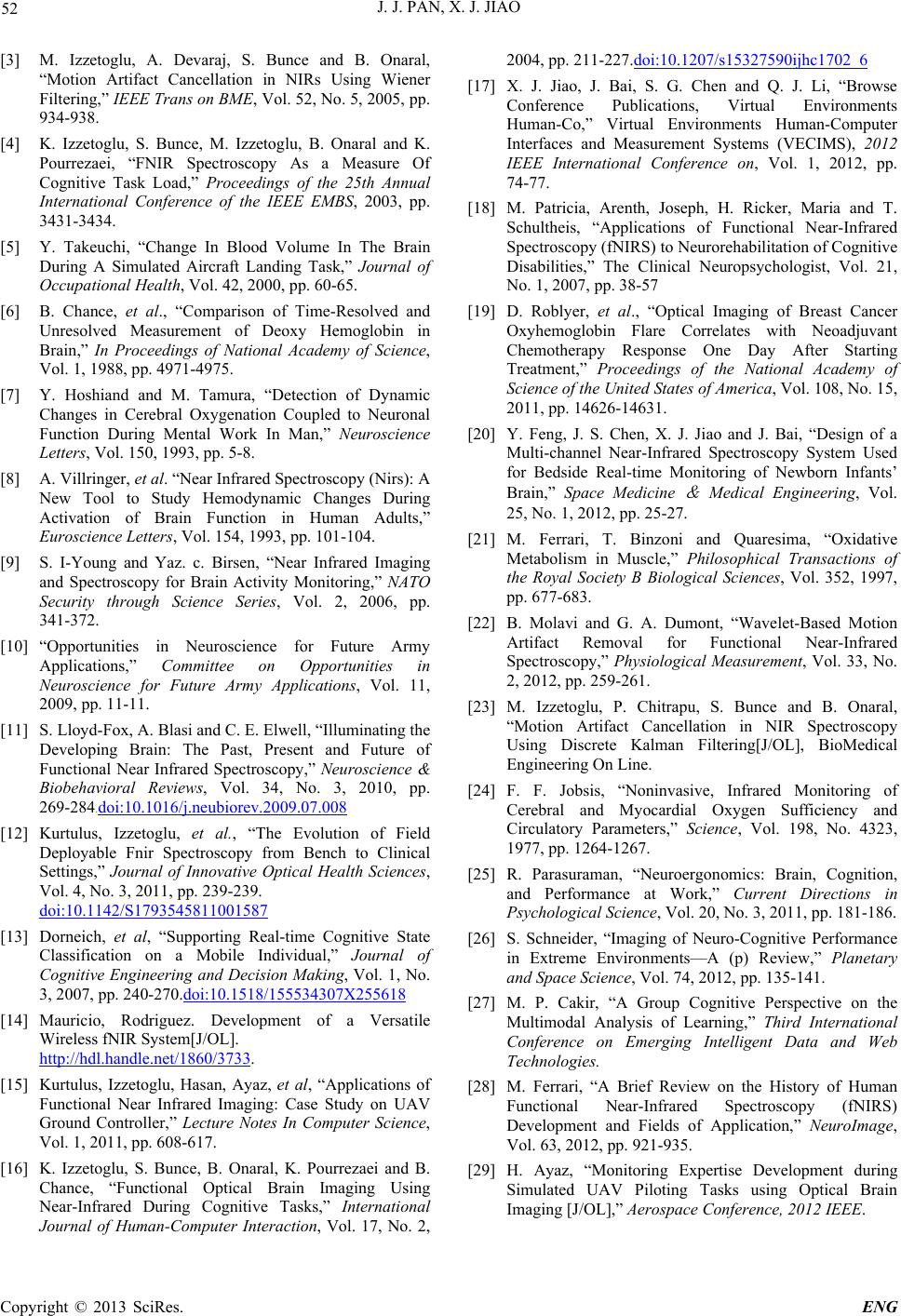
J. J. PAN, X. J. JIAO
Copyright © 2013 SciRes. ENG
52
[3] M. Izzetoglu, A. Devaraj, S. Bunce and B. Onaral,
“Motion Artifact Cancellation in NIRs Using Wiener
Filtering,” IEEE Trans on BME, Vol. 52, No. 5, 2005, pp.
934-938.
[4] K. Izzetoglu, S. Bunce, M. Izzetoglu, B. Onaral and K.
Pourrezaei, “FNIR Spectroscopy As a Measure Of
Cognitive Task Load,” Proceedings of the 25th Annual
International Conference of the IEEE EMBS, 2003, pp.
3431-3434.
[5] Y. Takeuchi, “Change In Blood Volume In The Brain
During A Simulated Aircraft Landing Task,” Journal of
Occupational Health, Vol. 42, 2000, pp. 60-65.
[6] B. Chance, et al., “Comparison of Time-Resolved and
Unresolved Measurement of Deoxy Hemoglobin in
Brain,” In Proceedings of National Academy of Science,
Vol. 1, 1988, pp. 4971-4975.
[7] Y. Hoshiand and M. Tamura, “Detection of Dynamic
Changes in Cerebral Oxygenation Coupled to Neuronal
Function During Mental Work In Man,” Neuroscience
Letters, Vol. 150, 1993, pp. 5-8.
[8] A. Villringer, et al. “Near Infrared Spectroscopy (Nirs): A
New Tool to Study Hemodynamic Changes During
Activation of Brain Function in Human Adults,”
Euroscience Letters, Vol. 154, 1993, pp. 101-104.
[9] S. I-Young and Yaz. c. Birsen, “Near Infrared Imaging
and Spectroscopy for Brain Activity Monitoring,” NATO
Security through Science Series, Vol. 2, 2006, pp.
341-372.
[10] “Opportunities in Neuroscience for Future Army
Applications,” Committee on Opportunities in
Neuroscience for Future Army Applications, Vol. 11,
2009, pp. 11-11.
[11] S. Lloyd-Fox, A. Blasi and C. E. Elwell, “Illuminating the
Developing Brain: The Past, Present and Future of
Functional Near Infrared Spectroscopy,” Neuroscience &
Biobehavioral Reviews, Vol. 34, No. 3, 2010, pp.
269-284.doi:10.1016/j.neubiorev.2009.07.008
[12] Kurtulus, Izzetoglu, et al., “The Evolution of Field
Deployable Fnir Spectroscopy from Bench to Clinical
Settings,” Journal of Innovative Optical Health Sciences,
Vol. 4, No. 3, 2011, pp. 239-239.
doi:10.1142/S1793545811001587
[13] Dorneich, et al, “Supporting Real-time Cognitive State
Classification on a Mobile Individual,” Journal of
Cognitive Engineering and Decision Making, Vol. 1, No.
3, 2007, pp. 240-270.doi:10.1518/155534307X255618
[14] Mauricio, Rodriguez. Development of a Versatile
Wireless fNIR System[J/OL].
http://hdl.handle.net/1860/3733.
[15] Kurtulus, Izzetoglu, Hasan, Ayaz, et al, “Applications of
Functional Near Infrared Imaging: Case Study on UAV
Ground Controller,” Lecture Notes In Computer Science,
Vol. 1, 2011, pp. 608-617.
[16] K. Izzetoglu, S. Bunce, B. Onaral, K. Pourrezaei and B.
Chance, “Functional Optical Brain Imaging Using
Near-Infrared During Cognitive Tasks,” International
Journal of Human-Computer Interaction, Vol. 17, No. 2,
2004, pp. 211-227.doi:10.1207/s15327590ijhc1702_6
[17] X. J. Jiao, J. Bai, S. G. Chen and Q. J. Li, “Browse
Conference Publications, Virtual Environments
Human-Co,” Virtual Environments Human-Computer
Interfaces and Measurement Systems (VECIMS), 2012
IEEE International Conference on, Vol. 1, 2012, pp.
74-77.
[18] M. Patricia, Arenth, Joseph, H. Ricker, Maria and T.
Schultheis, “Applications of Functional Near-Infrared
Spectroscopy (fNIRS) to Neurorehabilitation of Cognitive
Disabilities,” The Clinical Neuropsychologist, Vol. 21,
No. 1, 2007, pp. 38-57
[19] D. Roblyer, et al., “Optical Imaging of Breast Cancer
Oxyhemoglobin Flare Correlates with Neoadjuvant
Chemotherapy Response One Day After Starting
Treatment,” Proceedings of the National Academy of
Science of the United States of America, Vol. 108, No. 15,
2011, pp. 14626-14631.
[20] Y. Feng, J. S. Chen, X. J. Jiao and J. Bai, “Design of a
Multi-channel Near-Infrared Spectroscopy System Used
for Bedside Real-time Monitoring of Newborn Infants’
Brain,” Space Medicine
&
Medical Engineering, Vol.
25, No. 1, 2012, pp. 25-27.
[21] M. Ferrari, T. Binzoni and Quaresima, “Oxidative
Metabolism in Muscle,” Philosophical Transactions of
the Royal Society B Biological Sciences, Vol. 352, 1997,
pp. 677-683.
[22] B. Molavi and G. A. Dumont, “Wavelet-Based Motion
Artifact Removal for Functional Near-Infrared
Spectroscopy,” Physiological Measurement, Vol. 33, No.
2, 2012, pp. 259-261.
[23] M. Izzetoglu, P. Chitrapu, S. Bunce and B. Onaral,
“Motion Artifact Cancellation in NIR Spectroscopy
Using Discrete Kalman Filtering[J/OL], BioMedical
Engineering On Line.
[24] F. F. Jobsis, “Noninvasive, Infrared Monitoring of
Cerebral and Myocardial Oxygen Sufficiency and
Circulatory Parameters,” Science, Vol. 198, No. 4323,
1977, pp. 1264-1267.
[25] R. Parasuraman, “Neuroergonomics: Brain, Cognition,
and Performance at Work,” Current Directions in
Psychological Science, Vol. 20, No. 3, 2011, pp. 181-186.
[26] S. Schneider, “Imaging of Neuro-Cognitive Performance
in Extreme Environments—A (p) Review,” Planetary
and Space Science, Vol. 74, 2012, pp. 135-141.
[27] M. P. Cakir, “A Group Cognitive Perspective on the
Multimodal Analysis of Learning,” Third International
Conference on Emerging Intelligent Data and Web
Technologies.
[28] M. Ferrari, “A Brief Review on the History of Human
Functional Near-Infrared Spectroscopy (fNIRS)
Development and Fields of Application,” NeuroImage,
Vol. 63, 2012, pp. 921-935.
[29] H. Ayaz, “Monitoring Expertise Development during
Simulated UAV Piloting Tasks using Optical Brain
Imaging [J/OL],” Aerospace Conference, 2012 IEEE.